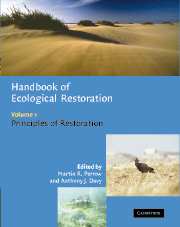Book contents
- Frontmatter
- Contents
- List of contributors
- Foreword
- Preface
- Part 1 The background
- Part 2 Manipulation of the physical environment
- Part 3 Manipulation of the chemical environment
- Part 4 Manipulation of the biota
- 12 Establishment and manipulation of plant populations and communities in terrestrial systems
- 13 Ecology and management of plants in aquatic ecosystems
- 14 Micro-organisms
- 15 Terrestrial invertebrates
- 16 Aquatic invertebrates
- 17 Fish
- 18 Reptiles and amphibians
- 19 Birds
- 20 Mammals
- Part 5 Monitoring and appraisal
- Index
- References
13 - Ecology and management of plants in aquatic ecosystems
Published online by Cambridge University Press: 29 December 2009
- Frontmatter
- Contents
- List of contributors
- Foreword
- Preface
- Part 1 The background
- Part 2 Manipulation of the physical environment
- Part 3 Manipulation of the chemical environment
- Part 4 Manipulation of the biota
- 12 Establishment and manipulation of plant populations and communities in terrestrial systems
- 13 Ecology and management of plants in aquatic ecosystems
- 14 Micro-organisms
- 15 Terrestrial invertebrates
- 16 Aquatic invertebrates
- 17 Fish
- 18 Reptiles and amphibians
- 19 Birds
- 20 Mammals
- Part 5 Monitoring and appraisal
- Index
- References
Summary
INTRODUCTION
Recently, research on aquatic plants has received considerable attention, both from a basic research point of view (to understand aquatic ecosystem behaviour and plant population dynamics), but also because of the importance of aquatic plants in restoration of shallow lakes, wetland management and nutrient removal from aquatic systems. Furthermore, research on aquatic plants is quite often derived from problems arising when exotic aquatic species invade ecosystems (Madsen et al., 1991), or when human impact makes native species into a nuisance. During the last decade there has been a shift in focus from factors affecting macrophytes, to how macrophytes affect the ecosystem (Carpenter & Lodge, 1986; Sondergaard & Moss, 1998).
Despite a considerable amount of research, we still lack knowledge on the relative importance of mechanisms regulating and structuring aquatic plant populations, and how vegetation affects the ecosystem. Basic knowledge regarding, for example, life-history characteristics, germination requirements or dispersal ecology of different species is also often lacking. It is also still surprisingly common for researchers to ignore or not fully appreciate the influence and importance of aquatic plants in theoretical as well as applied aspects of limnology (e.g. modelling and biomanipulation).
This chapter is an attempt to outline the basic forces structuring the distribution of aquatic vegetation, and to give examples on how knowledge about structuring forces can be used in management.
Definitions
The diverse and systematically heterogeneous group that comprise aquatic plants has challenged definition and classification.
- Type
- Chapter
- Information
- Handbook of Ecological Restoration , pp. 242 - 256Publisher: Cambridge University PressPrint publication year: 2002
References
- 5
- Cited by



